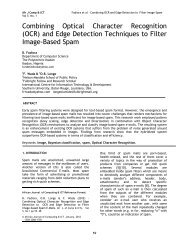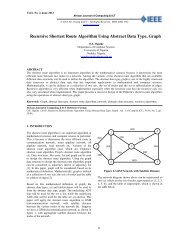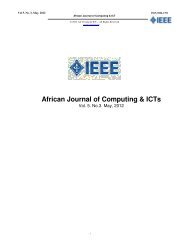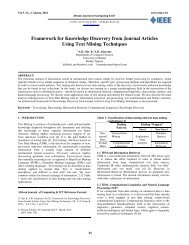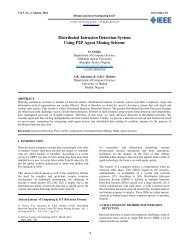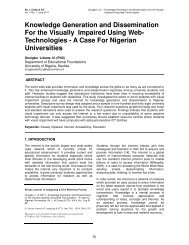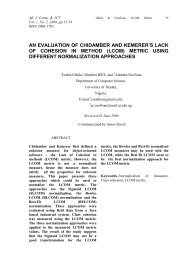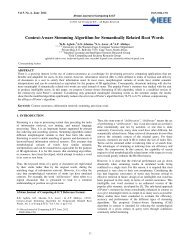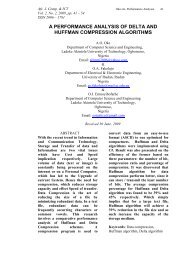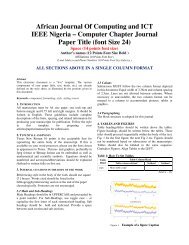Satisfaction With an E-Learning System - IEEE Afr J Comp & ICTs
Satisfaction With an E-Learning System - IEEE Afr J Comp & ICTs
Satisfaction With an E-Learning System - IEEE Afr J Comp & ICTs
You also want an ePaper? Increase the reach of your titles
YUMPU automatically turns print PDFs into web optimized ePapers that Google loves.
average time (Benbasat <strong>an</strong>d Dexter 1979), or<br />
confidence on the decision made (Taylor, 1975).<br />
(g) Org<strong>an</strong>izational Impact<br />
According to Delone <strong>an</strong>d Mcle<strong>an</strong> (2003),<br />
org<strong>an</strong>izational impact does not have a clear <strong>an</strong>d defined<br />
measurement variable. The measures c<strong>an</strong> be grouped<br />
into three different areas: studies that use profit, studies<br />
that use productivity, <strong>an</strong>d studies that use cost/benefit<br />
<strong>an</strong>alysis. From these three areas, studies select one or<br />
more measures to operationalize org<strong>an</strong>izational impact.<br />
For example, Benbasat <strong>an</strong>d Dexter (1985; 1986) have<br />
used profit <strong>an</strong>d profit perform<strong>an</strong>ce to measure<br />
org<strong>an</strong>izational impact. Miller (1987) utilized a costbenefit<br />
<strong>an</strong>alysis to study the success of the IS. Edelm<strong>an</strong><br />
(Edelm<strong>an</strong>, 1981) utilizes productivity as his outcome,<br />
<strong>an</strong>d <strong>an</strong> overall org<strong>an</strong>izational effectiveness is the<br />
selected outcome for Millm<strong>an</strong> <strong>an</strong>d Hartwick (1987).<br />
Delone <strong>an</strong>d Mcle<strong>an</strong> (2003) proposed <strong>an</strong> updated ISS<br />
model <strong>an</strong>d evaluated its usefulness in light of the<br />
dramatic ch<strong>an</strong>ges in IS practice, especially the<br />
emergence <strong>an</strong>d consequent explosive growth of webbased<br />
applications. Based on prior studies, the ISS<br />
model was updated by adding “service quality”<br />
measures as a new dimension <strong>an</strong>d by grouping all the<br />
“impact” measures into a single impact or benefit<br />
construct called “net benefit” (Delone <strong>an</strong>d Mcle<strong>an</strong>,<br />
2003). Thus, the updated model consists of six<br />
dimensions: (1) information quality (2) system quality<br />
(3) service quality (4) use/intention to use (5) user<br />
satisfaction <strong>an</strong>d (6) net benefits.<br />
RESEARCH MODEL<br />
The research model for the study was based on Delone<br />
<strong>an</strong>d Mcle<strong>an</strong>’s (2003) IS success model. The model<br />
proposed a number of relationships <strong>an</strong>d connections;<br />
such as system quality, information quality, service<br />
quality <strong>an</strong>d students’ satisfaction will directly affect<br />
intention to use as established in the hypotheses below:<br />
H1: There is no signific<strong>an</strong>t relationship between system<br />
quality of the e-learning system <strong>an</strong>d students’ intention<br />
to use it.<br />
H2: There is no signific<strong>an</strong>t relationship between<br />
information quality of the e-learning system <strong>an</strong>d<br />
students’ intention to use it.<br />
H3: There is no signific<strong>an</strong>t relationship between<br />
service quality of the e-learning system <strong>an</strong>d students’<br />
intention to use it.<br />
That is the perform<strong>an</strong>ce of system <strong>an</strong>d information<br />
quality determines the students’ intention to use<br />
(Guimaraes, Armstrong <strong>an</strong>d Jones2009; Swaid <strong>an</strong>d<br />
Wig<strong>an</strong>d 2009). While service quality differs in the way<br />
users measures it Aladw<strong>an</strong>i, (2002). Thus the model<br />
indicates that system, information, service <strong>an</strong>d<br />
students’ satisfaction ought to affect students’ intention<br />
to use.<br />
In addition, system quality, information quality <strong>an</strong>d<br />
service quality were also proposed to affect students’<br />
satisfaction. Fitzgerald & Russo, (2005), found that<br />
improved system quality was positively related to<br />
subsequent system use. Since system quality of e-<br />
learning directly affects students’ satisfaction, also it is<br />
naturally expected that the outcome of a good system<br />
lies in the quality of information output of that system<br />
(Mc Gill et al., 2003). Service quality also has to meet<br />
users’ expectations by ensuring the ease of information<br />
flow. It becomes imperative to assess the relationship<br />
of the constructs with students’ satisfaction <strong>an</strong>d this<br />
brought about the next three hypotheses.<br />
H5: There is no signific<strong>an</strong>t relationship between system<br />
quality of the e-learning system <strong>an</strong>d students’<br />
satisfaction.<br />
H6: There is no signific<strong>an</strong>t relationship between<br />
information quality of the e-learning system <strong>an</strong>d<br />
students’ satisfaction.<br />
H7: There is no signific<strong>an</strong>t relationship between<br />
service quality of the e-learning system <strong>an</strong>d students’<br />
satisfaction.<br />
Thus, the research model assumed that there would be<br />
correlation between system quality, information quality<br />
<strong>an</strong>d service quality with students’ satisfaction<br />
Finally, students’ satisfaction was assumed to directly<br />
affect the use of e-learning. The impact of a system on<br />
users c<strong>an</strong> only be measured based on its usage. Quality<br />
of the system notwithst<strong>an</strong>ding, if a system has poor<br />
patronage, its perception in term of usefulness <strong>an</strong>d<br />
efficiency will be judged poor by users. Therefore the<br />
last hypothesis was stated thus:<br />
H8: There is no signific<strong>an</strong>t relationship between<br />
students’ satisfaction with the e-learning system <strong>an</strong>d its<br />
use.<br />
H4: There is no signific<strong>an</strong>t relationship between<br />
students’ satisfaction with the e-learning system <strong>an</strong>d<br />
intention to use it.<br />
132



